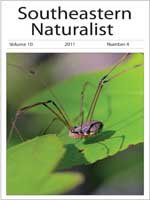We surveyed the Lower Mississippi Alluvial Valley of Arkansas (“the Delta”) during the breeding seasons of 2005 and 2006 using the national marshbird monitoring protocol for secretive marshbirds. We detected and documented breeding by Podilymbus podiceps (Pied-billed Grebe), Ixobrychus exilis (Least Bittern), Rallus elegans (King Rail), and Gallinula chloropus (Common Moorhen). We detected but did not document breeding by Botaurus lentiginosus (American Bittern), Porphyrula martinica (Purple Gallinule), and Fulica americana (American Coot), all of which have been documented to breed in the Delta. Our estimated occupancy rates for breeding marshbirds in the study area ranged from a low of 6% for the King Rail in 2006 to a high of 27% for the Least Bittern in 2005. The range of these occupancy rates are low and reflect the rarity of secretive marshbirds in the Delta. Secretive marshbird occupancy rates were higher in the southern third of the Delta, probably because wetlands were more abundant or of higher quality there.
How to translate text using browser tools
1 December 2011
Status and Distribution of Breeding Secretive Marshbirds in the Delta of Arkansas
Michael J. Budd,
David G. Krementz
ACCESS THE FULL ARTICLE

Southeastern Naturalist
Vol. 10 • No. 4
December 2011
Vol. 10 • No. 4
December 2011




